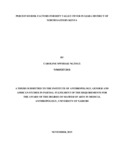| dc.description.abstract | Background: Zoonotic diseases are gaining importance globally and Rift Valley Fever (RVF) is no exception. Outbreaks of RVF have occurred in the North Eastern region of Kenya intermittently and with the potential for spread to other regions in Kenya, regionally and globally. Human behavioral factors have already been identified as central in perpetuating this spread as well as contributing to human infections. This study was aimed at identifying the lay beliefs and perceived risk factors for Rift Valley Fever in Ijara, North Eastern Kenya.
Methods: The study design was cross sectional and descriptive in nature and adopted qualitative methods of data collection. Specifically, focus group discussions, key informant interviews and narratives were used to collect the data. Sixteen people participated as key informants, six in the narratives and eight focus group discussions were conducted, four with men and an equal number with women. The informants were recruited from among community members who are residents of Ijara District. The discussions and interviews were taped, notes taken, transcribed and data analysis was thereafter done thematically. The theory that guided this study was the Health Belief Model.
Results: This study established that the discussants and informants perceived that there was a relationship between unusually heavy rainfall, flooding, mosquitoes and the occurrence of RVF. They also noted that the mosquitoes differed in appearance and believed that the main cause of RVF was the mosquitoes. However, livestock related activities especially consumption of meat and milk from infected animals were not perceived as risk factors for RVF because many people did not get RVF even after consuming meat and milk from ill animals.
Consequently, the study identified that the community engaged in risky activities during the last RVF outbreak. These included residing with livestock, consuming raw milk and meat from sick animals and sleeping outside without the use of mosquito nets. The informants cited various reasons for this which included lack of alternative sources of food, preference for raw milk and offering protection for their animals from the harsh weather and wild animals. The community members indicated that they had been told by government officials that consuming milk and meat products from sick animals were risk factors for RVF. However, they did not believe this to be true and continued with these practices even during the RVF
Conclusion and Recommendations: The local people have some relevant knowledge on RVF but lack sufficient information on the link between their animal husbandry practices and RVF. This study therefore, recommend proper health awareness and education regarding the risk factors for RVF taking into consideration the beliefs and socio economic dynamics of the communities in this region given that they primarily depend on livestock for livelihood.
Policy makers need to develop health messages regarding RVF that take into consideration the community’s lay beliefs to counter rumors and misinformation. Concerted efforts by all stakeholders are also needed to provide alternative means of livelihood during and after RVF outbreaks to mitigate against the challenges experienced by these communities. There is need for further in depth studies on community perceptions regarding informal and formal healthcare in the treatment of RVF to provide information that would facilitate timely and effective management of RVF patients through the provision of culturally relevant treatment approaches. | en_US |

